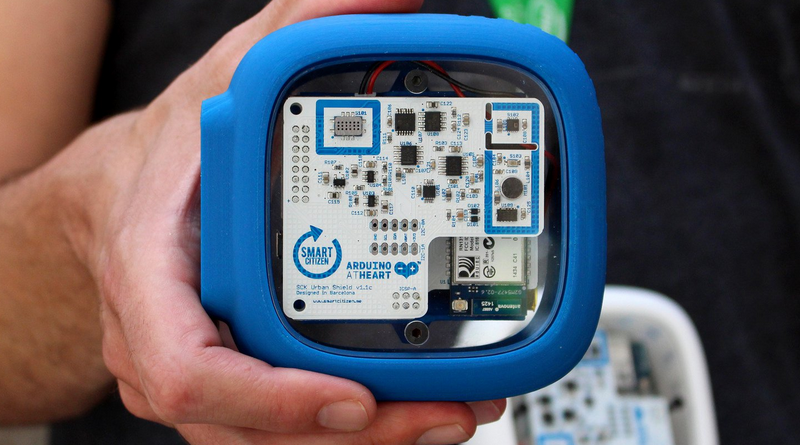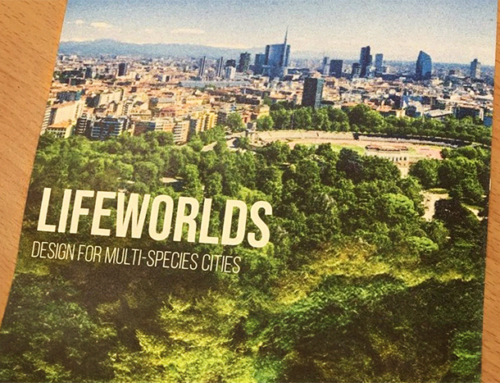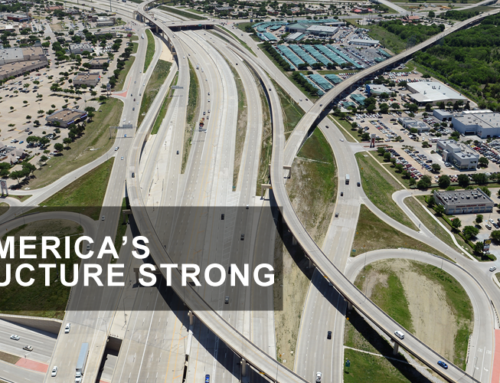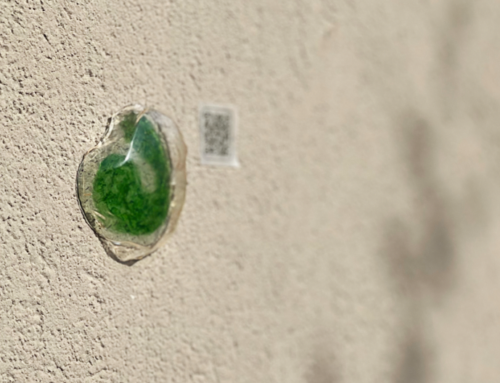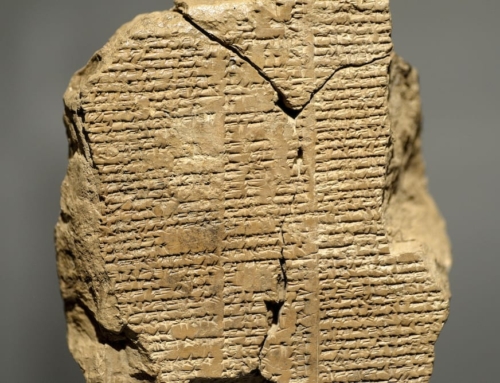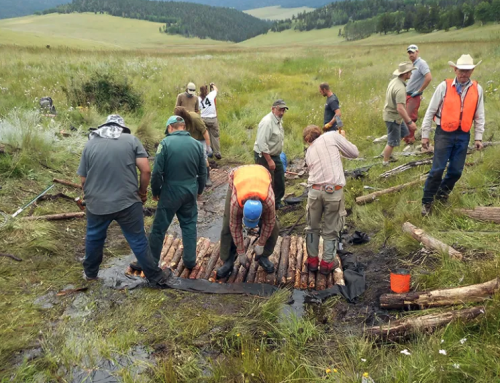The following text appears in the inaugural edition of Ding, a new magazine about the Internet and things, published by the Mozilla Foundation. Ding will be launched at MozFest in London on 27-29 October.
On a recent visit to @IAAC in Barcelona, I was charmed by their Smart Citizen platform that enables citizens to monitor levels of air or noise pollution around their home or business.
The system connects data, people and knowledge based on their location; the device’s low power consumption allows it to be placed on balconies and windowsills where power is provided by a solar panel or battery.
Smart Citizen is just one among a growing array of devices that can sense everything from the health of a tomato in Brazil, to bacteria in the stomach of a cow in Perthshire – remotely.
Low-cost sensing technologies allow citizens to assess the state of distant environments directly. We can also measure oil contamination in our local river with a smartphone. Thousands of people are monitoring the air they breathe using Air Quality Eggs.
This innovation is intriguing, but leaves a difficult question unanswered: Under what circumstances will possession of this data contribute to the system transformation that we so urgently need?
Info-Eco Scenarios
When we first posed that foundational question at our third Doors of Perception conference in 1995, when our theme was “Info-Eco”, ecological monitoring and remote sensing were the most popular scenarios to be proposed.
Twenty two years later, the proliferation of tools and platforms is glorious – but our journey is only half complete. Remote sensing and monitoring have turned not, on their own, to be agents of system change.
Or not yet. Twenty two years is not that long when compared to the scale of transformation we are embarked on.
Over centuries, our cultures have been rendered cognitively blind by a metabolic rift between people and the earth. Paved surfaces, and pervasive media – developed over generations – now shield us from direct experience of the damage we’re inflicting on soils, oceans and forests.
This metabolic rift explains how we’re able put the health of ‘the economy’ above all other concerns. We invest immense effort and resources in a quest for speed, perfection and control but, because we inhabit an abstract, digitally diminished world, we’re blind to the true costs of our activities.
The energy we use is literally invisible. The destructive impacts caused by resource extraction are usually felt by other people, somewhere else.
For the philosopher John Zerzan our planet-wide dissociative mental state began when we placed language, art, and number above other ways of knowing the world. Every representation, he argued, both simplifies, and distances, earthly reality. Our reliance on data underpins a concept of progress in which embdied, analogue local knowledge is downgraded and often disregarded.
Vital knowledge
We once knew better. For much of human history, the idea that the world around us is ‘vital’ was literally common knowledge. Greek philosophers known as ‘hylozoists’ made no distinction between animate and inanimate, spirit and matter. Roman sages thought likewise.
In his epic work On The Nature of Things, the poet Lucretius argued that everything is connected, deep down, in a world of matter and energy. Chinese philosophers, too, believed that the ultimate reality of the world is intrinsically connective; in the Tao, everything in the universe, whether animate or inanimate, is embedded in the continuous flow and change.
Buddhist texts, too, evoke a universe that’s in a state of ceaseless movement and connection. And as recently as the seventeenth century, in Europe, the Dutch philosopher Baruch Spinoza conceived of existence as a continuum, an inseparable tangle of body, mind, ideas and matter.
The belief that matter matters, so to speak, was then obscured – for two intense centuries up until about now – by two developments: the fire and smoke of the thermo-industrial economy, and, more recently, by global communication networks.
Now, as this self-devouring system unravels, the healing idea that that we are part of a world of living things, not separate from it, is resurfacing.
This reconnection with suppressed knowledge is not superstitious. Developments in science are confirming confirm the understanding in wisdom traditions that no organism is truly autonomous.
In systems thinking and resilience science, and from the study of sub-microscopic viruses, yeasts, bacteria in our gut, ants, mosses, lichen, slime moulds and mycorrhizae, trees, rivers and climate systems, old and new narratives are converging: our planet is a web of interdependent ecosystems.
These natural phenomena are not only connected; their very essence is to be in relationship with other things – including us. On a molecular, atomic and viral level, humanity and ‘the environment’ literally merge with one another, forging biological alliances as a matter of course.
The importance of this new perspective is profound. The division between the thinking self, and the natural world – a division which underpins the whole of modern thought – is beginning to dissolve. It follows that the great work of our time – and an answer to the value question that has so perplexed the Internet of Things – is to re-connect us – viscerally, and emotionally – with the living systems we’ve lost touch with.
But how?
Going forward, our work needs to focus on three things.
First, we need to work with scientists to develop benchmarks against which to compare the data being collected. There’s plenty of knowledge to connect with. An ecology metrics list on Github lists an astonishing three thousand terms – from molecular phylogenetics to microrefugia. And a European platform called Everyaware combines sensing technologies, networking applications and data-processing tools in one platform. The proposition is that connecting people with their environment creates “more effective and optimized relationships”.
A second success factor for reconnection is a bioregional narrative. Connecting the dots, revealing system-level patterns, and searching for root causes, will be most meaningful, as well as just interesting, within a framework of bioregional stewardship. A bioregion re-connects us with living systems, and each other, through the places where we live, and through our bodies – not just through our ever-active minds.
A bioregional focus reminds us that we live among watersheds, foodsheds, and fibersheds– not just in cities, towns, or ‘the countryside’.Growth, in a bioregion, is redefined in a healthier way, too – as improvements to the health and carrying capacity of the land, and the resilience of communities. And because value is created by stewardship, not extraction, a bioregion frames the next economy, not the dying one we have now.
Third: in our ongoing search for new and better ways of knowing – and being – we have huge amounts to learn from non-literate and indigenous cultures whose experience of the world is more direct than our own.
(Above) The deep knowledge of tribal communities about medicinal herbs and plants needs to be respected equally with data we collect using IoT devices. Photo: VGKK, BR Hills, courtesy of Quicksand
The way ahead will be based on a combination of knowledge obtained remotely, using modern tools and devioces, and ways of knowing that are local, experienced directly, contextual, and embodied.
When we connect with living systems emotionally, and not just rationally, and focus on the informal, the local and the conversational – things will really begin to change.
